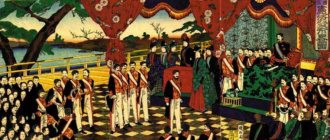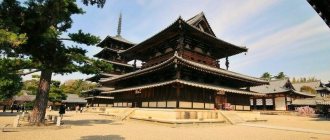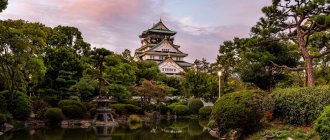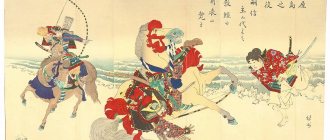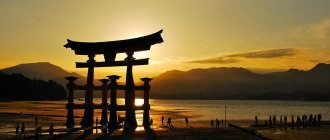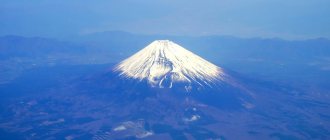Economic development of Japan
The bourgeois transformations carried out in Japan after the revolution of 1867-1868 directed the country along the path of capitalist development. The Japanese government took industrial development under its patronage, generously subsidizing the construction of enterprises and railways. The government paid special attention to the creation of the military industry. The expansion of industry was accompanied by its concentration. Two giant concerns began to play a major role in Japan:
- Mitsui and
- Mitsubishi,
competing with each other. They united banks, coal mines, factories and many other enterprises.
However, as a result of the incompleteness of the bourgeois revolution, many remnants of feudalism remained in Japan. The political sphere was dominated by an absolute monarchy. In the villages, enslaving conditions for peasants renting land from landowners continued to exist. The miserable existence of peasants and the extremely low (much lower than in Europe) wages of workers narrowed the domestic market. This circumstance strengthened the desire of Japanese capitalists to seize colonial possessions.
In order to implement an aggressive imperialist policy, the Japanese big bourgeoisie established an alliance with the samurai - the so-called Japanese nobility and the military that came from its midst.
Japan in the second half of the 19th - early 20th centuries
Read more: Features of economic development. The role of the state in the creation of modern industry. The emergence of concerns
Essay
Japan in the second half of the 19th - early 20th centuries
1. Meiji era. Civil war and elimination of the shogunate
At the end of the 60s of the 19th century, events occurred in Japan that radically changed the course of the historical development of this country. In official Japanese historiography they received the name “Meijijishin”, which translates as restoration of the monarchy.
The restoration of imperial power as real and the overthrow of the shogunate are a kind of key events in the political life of the country, which, on the one hand, seemed to crown the struggle of anti-shogun forces, and on the other, opened the way leading to deep social transformations.
Shogunate - formed in the XII-XIX centuries. in Japan, a form of government of the country by large feudal lords, in which the emperor was deprived of real power.
The movement to overthrow the shogunate united almost all layers of Japanese society: the peasantry, the urban poor, the opposition-minded nobility represented primarily by the lower samurai, and the commercial and industrial bourgeoisie. The wide scope of the anti-shogun movement, despite the heterogeneity of its participants and the presence of serious disagreements in the leadership, testified to a crisis not only at the top, but also at the feudal system itself.
With a superficial approach to the events of 1867-1868. they can be perceived as a clash between two feudal factions: on the one hand, the Tokugawa clan (the last of the three shogunal dynasties, which ruled from 1603 to 1867), and on the other, the opposing feudal lords from the southwestern principalities (Satsuma and Choshu), who, having concluded a military alliance among themselves, opposed the shogunate, achieved its overthrow and formed a new government, where the leaders of these principalities began to play a leading role. It is important that the intensification of the struggle within the ruling class occurred against the background of the growth of a powerful peasant movement, which threatened to develop into an agrarian revolution, as well as the movement of the urban lower classes.
By 1868, revolutionary events were developing in two streams: on the one hand, the movement of the masses, which had a pronounced anti-feudal character; on the other, the struggle of the nobility represented by the “enlightened samurai”, who sought to reform the existing system and change the form of government of the country. Both of these streams, for all their independence, were not isolated from each other, but developed in close interconnection. Moreover, anti-shogun-minded samurai not only used the revolutionary movement of the masses, but often led it, directing it into the general direction of the struggle against the existing regime.
Samurai - in a broad sense - the secular nobility in Japan, in the narrow and most often used meaning - the military class of small nobles. The term "samurai" is also used to refer to the Japanese military.
At the same time, the “enlightened samurai” itself was under the strong influence of the emerging bourgeoisie and, to a certain extent, expressed its interests. Thus, among the demands put forward by the anti-shogun opposition, issues related to the introduction of complete freedom of trade and business activity occupied an important place. Of no small importance was the fact that the leading Western countries demanded that Japan abandon the “closed country” policy pursued by the Tokugawa house and open its borders to the entry of foreign goods. The southwestern principalities, which formed the basis of the anti-shogun coalition, established fairly close ties with Western countries, in particular with England, and enjoyed their support and patronage.
Thus, Japanese society in the 60s of the 19th century was characterized by the active formation of a broad coalition of various social forces united by a common goal - the overthrow of the power of the shogunate as a spokesman for the interests of large feudal lords, as a stronghold of Japanese feudalism. The victory won by the troops of the southwestern principalities in 1868 predetermined the fall of the old regime and the establishment of a new government that set a course for the development of free enterprise, the elimination of the military class, and the strengthening of the positions of new landowners and rich peasants.
Having defeated the shogun's troops, Emperor Mutsuhito entered his capital, Tokyo, and united religious and secular power in his hands. Mutsuhito's reign was called the Meiji Era or "Enlightened Reign".
2. Administrative, military and agrarian reforms
The government of Emperor Mutsuhito declared Tokyo the capital of the state and began intensive reforms that cleared the way for market relations.
In 1872, the principalities were abolished and instead of the previous four, three estates were established: the highest nobility, which included former feudal princes and the court aristocracy; the nobility, to which all former samurai were classified; simple people, which included the rest of the population, including the commercial and industrial bourgeoisie. All classes were formally equal in rights. Common laws were established throughout the country and a unified judicial system was created. All regulation of professions and occupations was abolished, guilds and guilds that interfered with free enterprise were liquidated.
In December 1872, a Decree was issued introducing universal military service. The Japanese army was being rebuilt along European lines.
In 1873, an agrarian reform was carried out. She abolished feudal ownership of land, peasants received private ownership of the land they cultivated. At the same time, they had to pay a heavy land tax equal to 3 times the value of the land, and the land was valued very highly. About 1/3 of all arable land in the country was left to the so-called new landowners - people from the peasant elite, merchants, moneylenders, to whom the peasants mortgaged the land before the reform and could not buy it back. These landowners, most of whom lived in cities (“absentee landowners”), rented out land on enslaving terms to landless and land-poor peasants. Over time, most peasants lost their own land and became tenants and semi-tenants.
The government carried out important reforms in the field of education. Universal primary education according to the European model was introduced, and secondary schools and universities were created. Newspapers began to be published and books by European authors began to be translated. Missions were sent to the United States and European countries to familiarize themselves with the life of their peoples. The government ratified treaties concluded with foreign powers and established diplomatic relations with them.
Read more: Features of economic development. The role of the state in the creation of modern industry. The emergence of concerns
Information about the work “Japan in the second half of the 19th - early 20th centuries”
Section: History Number of characters with spaces: 16978 Number of tables: 0 Number of images: 0
Similar works
Russian foreign policy in the Far East in the second half of the 19th and early 20th centuries.
17408
0
0
... the shame, which claimed tens of thousands of human lives, played a role in the development of the revolution of 1905-1907. Conclusion Thus, this work examines the features of Russian foreign policy in the Far East at the end of the 19th and beginning of the 20th centuries. To summarize all of the above, I would like to note the following. So, in the 90s of the XIX century. the activity of Russian foreign policy was concentrated...
History of Russia in the second half of the 19th – early 20th centuries
64510
0
0
...: dispute and agreement. // New and recent history. - 1995 - No. 6. pp. 103-120. (Ideology of populism). 19. Budnitsky O.V. “Blood according to conscience”: terrorism in Russia (second half of the 19th - 20th centuries) // Domestic history. - 1994. No. 6. P. 203-209. 20. Tkachenko P.S. Student unrest at Moscow University in 1869. // Bulletin of Moscow University. Ser.8. Story. 1991 - No. 4. P. 71-76. ...
Russian foreign policy in the second half of the 19th century
35450
0
0
... USA in the North Pacific Ocean in the middle of the 19th century and the purchase of Alaska in 1867. Tomsk, 1976, p. 31. Voipgolovsky G. On different sides of the Bering Strait // World Economy and International Relations. 1986, K_b. P. 38. 9) History of economic development of China (1840-1948). Collection of static materials. Per. from Chinese. M„ 1958 10) Kinyapina N.S. Russian foreign policy in the second half
International policy of Japan at the end of the 16th - first half of the 19th centuries.
112423
2
0
... as well as public schools. In light of the slow disintegration of the feudal order in the country, a gradual “ripening” of capitalist prerequisites began: the number of manufactories increased. In the first half of the 19th century, more than 180 new manufactories arose in Japan, which were opened with funds from merchants and bakufu. Manufacturing production was mainly textile (divided into spinning and...
Introduction of the Constitution in 1889 in Japan
Economic transformations in Japan led to the growth and political strengthening of the bourgeoisie, which began to lay claim to leadership in the state. A bourgeois-liberal movement began to develop in the country for the introduction of a constitution limiting the autocracy of the emperor.
The government decided to make some concessions and introduced a constitution in 1889 (see document). A parliament was created in the country, consisting of two chambers: an upper and a lower one. The upper house for the most part was not elected. It consisted of people appointed by the emperor, and of representatives of the highest nobility, who received hereditary rights to participate in the upper house. Thus, the latter resembled the English House of Lords.
The lower house was elected, but only rich people enjoyed the right to vote. The power of parliament was small, while the power of the emperor, even after the introduction of the constitution, remained enormous. Every law passed by parliament was sent to the emperor for approval in order to enter into force. The cabinet of ministers was responsible to him, and not to parliament. The emperor had the right to declare war and conclude peace. He held supreme command of the army and navy. Military circles played a very important role in the Japanese government.
The parliamentary elections took place in an atmosphere of bribery and violence. Power in Japan after the adoption of the constitution was still concentrated in the hands of the most reactionary elite of semi-feudal landowners and the big bourgeoisie.
Reform period, Japan 18th, 19th century
At the beginning of the 18th century, the Japanese economy was in crisis. It appeared as a result of the ruin of the natural economy due to the spread of monetary relations in the villages. The price of rice fell sharply, causing a budget shortage for the capital and regional governments, which were dependent on taxes in kind. As a result, in 1716, shogun Tokugawa Yoshimune began to carry out all-Japanese reforms, which were called the “Kyoho reforms.” Their main principles were awakening economy among officials, plowing up virgin lands and raising taxes.
In addition, the shogun approved the “Regulations on Legal Proceedings,” in which he specified the rules for conducting litigation and allowed commoners to file complaints against managers. His reforms were supported by the roju Tanuma Okitsugu. He sought to cope with the crisis by improving commodity-money relations and approved the formation of monopoly trade associations. But the involvement of merchants in politics led to increased corruption, and the reformer was forced to leave his post.
In 1787, economic reforms were taken up by Matsudaira Sadanobu. His policy was called the "Kansei reforms", the main goal of which was "richness through economy." Despite this, socio-economic difficulties were not overcome. After Matsudaira's death, shogun Tokugawa Ienari took up the problems of the state. He continued policies to support trade and urban development.
Koban, Japanese currency
At the beginning of the 19th century, the Japanese archipelago was shaken by severe famine caused by constant crop failures. Instead of helping the population, the government began purchasing rice from the provinces and sending it to the seat of government. This course led to armed uprisings not only of the common people, but also of the regional samurai, which was the support of the shogunate. To defuse the situation, the government began to carry out “Tempo reforms” in 1841 under the leadership of Mizuno Tadakuni. Their task was to resume traditional methods of farming: conservation of the village and containment of trade relations. But the changes were unpopular, which again reduced the authority of the government.
At the same time, the authorities of the eastern Japanese isolated provinces of Choshu Han and Satsuma Han overcame economic difficulties on their own. They brought gifted samurai from the ranks into leadership and vigorously supported trade. Within a short time, both provinces had gained sufficient power to rival the shogunate.
Edo culture, Japan 17th-19th century
In the 17th-19th centuries, the traditional culture of Japan was finally formed. At the end of the 17th and beginning of the 18th century, Osaka and Kyoto were all-Japanese centers of culture and science, and in the second half of the 18th century, these functions were performed by the city of Edo. The culture of the Kyoto-Osatsu era is called the Genroku culture, and the culture of the Edo period is called the Kassho culture. They are named after the corresponding slogans of the Emperors' rule.
A distinctive feature of the Genroku culture was the creation of illustrated “modern tales” (Japanese ukiyo-zoshi) - a style of Japanese literature, a variation of stories with pictures of the second half of the 17th - early 18th centuries. Another genre, ukiyo-bon (Japanese for “modern books”), told about the daily life of townspeople. Kabuki dance was transformed into theater. Poetry gained great popularity in the person of Matsuo Basho, who raised the art of haiku poetry to new heights.
The Ningyo-jururi puppet theater spread thanks to the poetic productions of playwright Chikamatsu Monzaemon. In the arts, artists from the Kano, Rin and Tosa schools worked energetically. At the same time, a new style of ukiyo-e prints was created, the founder of which was Hishikawa Moronobu. In addition, exact and natural sciences, especially agronomy and mathematics, developed.
The Kasey culture is characterized by the development of a subculture of commoners and the popularization of hedonistic teachings. The people of Edo read comedy stories like Jippensha Ikku's "On Foot Along the Tokaido Way," Shikitei Samba's "Modern Baths," and fantasy literature like "The Story of the Eight Dogs of Satomi of South Ava" by Kyokutei Bakin. Famous poets were Yosa Buson and Kobayashi Issa. The theater was at the height of its glory. Courtesan houses became very popular. Ukiyo-e prints found a new birth thanks to portrait painters Kitagawa Utamaro and Toshusai Sharaku, landscape painters Katsushika Hokusai and Hiroshige Utagawa. In the samurai class, traditional painting by artists Ike no Taiga and Uragami Gyokudo was in fashion.
In the 18th and 19th centuries, the level of education in Japan was one of the highest in the world. In addition to public schools for samurai, terakoya were created for ordinary people. The main subjects were writing, reading, accounting and the essence of Confucianism. In addition, new sciences were taught, for example, “the study of Holland” rangaku and “Japanese studies” kokugaku. The principles of kogutaku were founded by Motoori Norinaga, who sought to prove Japanese individuality. The reasons for the creation of rangaku were the translations of scientific works from Europe by Maeno Ryotaku and Sugita Gempaku. They helped establish Western academism in Japan. The end of the Edo era saw a rise in interest in Japanese history, spurred by the writing of Rai San'yo's Unofficial History of Japan.
Three Beauties (1793)
Nikko Brahma, Ieyasu Shrine
Japan's aggressive foreign policy
The rapid growth of Japanese capitalism was accompanied by wars of conquest. The geographical proximity of the huge but weak China and the remoteness of its major rivals gave Japanese capitalism a certain advantage. It was especially easy and convenient for the Japanese imperialists to plunder the Chinese people.
As a result of the Sino-Japanese War of 1894-1895. Japan defeated and thoroughly plundered China. However, not content with this, the Japanese imperialists began to prepare for a war with Russia for the redistribution of spheres of influence in the Far East. Japan sought to take over China
- northeastern provinces (Manchuria) and
- Korea.
The Japanese imperialists also dreamed of seizing Russian lands - the island of Sakhalin and even the entire Russian Far East. In preparation for war with Russia, Japan entered into an alliance with England in 1902.
Japanese spies and intelligence officers, taking advantage of the carelessness of the tsarist government, flooded the Far Eastern regions of Russia. Under the guise of merchants, hairdressers, laundresses, etc., they penetrated into fortified areas, found out the location of military units, their movements and combat readiness.
Japan was well prepared for war. She was provided with British and American support.
Russo-Japanese War
At the beginning of 1904, the Japanese navy, without declaring war, attacked the Russian fleet in Port Arthur and sank several warships. As a result of the surprise attack, Japan achieved superiority at sea. Taking advantage of this, she transferred a significant army to Manchuria by sea, well armed with the help of England, and began to push back the tsarist troops.
Russia, due to the fault of the tsarist government, was completely unprepared for a major war on a distant front. Despite the heroism of Russian soldiers and sailors, the tsarist army and navy were defeated. It was not Russia and not the Russian people that were defeated in this war. The tsarist regime was defeated, having criminally plunged the people into an alien imperialist war and, moreover, not being prepared for it.
Having suffered defeat, the tsarist autocracy, frightened by the growth of the revolutionary movement in the country, hastened to make peace with Japan. According to the peace treaty concluded in 1905 in Portsmouth (USA), Japan captured the southern half of Sakhalin Island, the cities of Port Arthur and Dalny on the Liaodong Peninsula, previously leased by Russia from China. Russia recognized Japan's predominant influence in Korea and Southern Manchuria. Moreover, the frightened Tsar gave Japan the original Russian land -.
The Russo-Japanese War was one of the first imperialist wars for the territorial redistribution of land by the largest capitalist powers.
Labor movement in Japan
In Japan itself, the situation of workers in the 20th century. it was still quite difficult. The workers lived in barracks and barracks, where prison rules reigned. Often workers were kept locked in barracks. There was a case when a fire broke out in one such barracks, and out of 50 female workers locked in it, 31 died in the flames. The workers received starvation wages and worked 12-14 hours a day . There was no legislation protecting workers' rights in the country.
Japanese workers began to speak out against the arbitrariness of their employers and government. Already in the 80s they tried to organize trade unions, and in the 90s a wave of strikes and demonstrations swept across the country.
During these same years, the Japanese revolutionary Sen Katayama began promoting socialism. In 1901, with the close participation of Katayama, the Socialist Party was organized in Japan . However, the Japanese government soon passed a law dissolving it. Members of the Socialist Party were subjected to repression.
Other workers' organizations arose, despite the fact that the government imprisoned anyone suspected of belonging to them.
Revolutionary sentiments grew among the working class. During the Russo-Japanese War, advanced Japanese workers sent Russian workers a letter condemning the imperialist war. At the Congress of the Second International in Amsterdam in 1904, Katayama declared the complete solidarity of the Japanese proletariat with the Russian. He demonstratively shook hands with the representative of the Russian labor movement G. V. Plekhanov. Under the influence of the Russian Revolution, the Socialist Party was again organized in Japan in 1906. One of its prominent figures was Kotoku , who sharply criticized the reformist compromisers. True, while leading the revolutionary struggle, he himself made mistakes of an anarchist nature.
To get rid of Kotoku, who was very popular among the workers, the government accused him of plotting against the emperor. Kotoku, his wife and his closest comrades were captured and imprisoned. There they suffered a terrible fate: they were strangled.
Most of the active participants in the socialist movement were thrown into prison. Police repression dealt such a severe blow to the labor movement that it temporarily died out. It revived again under the influence of the Great October Socialist Revolution.
Sela
The Japanese economy of the Edo era was semi-subsistence in nature and dependent on tribute rice supplies. Its collection was carried out in villages by local officials - village heads nanusi or shoya, heads of fives and peasant delegates who controlled communal arable land, mountains and waters, and also performed various administrative functions. Decisions were made collectively. Residents of the villages were divided into fives, their members were in mutual responsibility, jointly paying tribute and preventing the commission of crimes. In one village, there were customs of mutual assistance between the fives.
— — Do you need help creating a study plan? — Specify a topic and receive a response in 15 minutes — — — — — — get help — —
In order to stabilize the supply of tribute in rice, the shogunate banned the sale of land and limited the peasants, concentrating them exclusively on field work and various duties. Most villages paid taxes on time, considering them a matter of national importance. However, sometimes exorbitant exactions forced peasants to complain to the daimyo or directly to the shogun, or, in extreme cases, to start peasant uprisings.
DOCUMENTS AND MATERIALS - FROM THE CONSTITUTION OF 1889
- Art. 1. The Japanese Empire is ruled by a continuous imperial dynasty for eternity...
- Art. 5. The Emperor exercises legislative power in agreement with the Imperial Parliament...
- Art. Yu. The Emperor establishes the organization of the various branches of government, appoints and dismisses all civil and military officials and determines their salaries...
- Art. 11. The Emperor is the supreme commander of the army and navy...
- Art. 13. The Emperor declares war, establishes peace and concludes treaties...
- Art. 33. The Imperial Parliament consists of two houses: the House of Peers and
- Chamber of Deputies...
- Art. 34. The House of Peers consists of members of the imperial family, holders of noble titles and persons appointed to it by the emperor...
- Art. 55. Each of the ministers of state gives his advice to the emperor and is responsible to him for them.
- All laws, imperial decrees and acts of every kind concerning public affairs must be sealed by the minister of state.
- Art. 56. The Privy Council discusses, in accordance with the regulations concerning the organization of the Privy Council, the most important state affairs when the Emperor requests it...:
- “Constitutions and legislative acts of bourgeois states”, vol. I, M., 1938, pp. 190-197.
Dates to remember
- 1904-1905 — Russo-Japanese War,
- < REVOLUTIONS IN IRAN AND TURKEY AT THE BEGINNING OF THE XX CENTURY
- -> PHOTOS OF WARFARE SHIPS OF THE IMPERIALIST STATES AT THE TURN OF THE 19th-20th CENTURIES, PAINTED AND DIGITIZED IN COLOR 1860 TO 1918 (WORK BY A JAPANESE IROOTOKO) >


